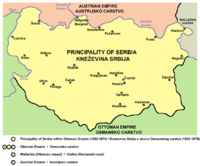Second Serbian uprising
The Second Serbian Uprising ( Serbian : drugi srpski ustanak ) from 1815 to 1817 was the second phase of the national revolutionary uprising of the Serbs against the Ottoman Empire , which broke out shortly after the renewed annexation of Serbia by the Ottoman Empire. The uprising eventually led to the limited independence of Serbia . The Principality of Serbia , as it was called, was ruled by its own parliament in the new capital Belgrade , had its own constitution and a royal dynasty.
background
In the First Serbian Uprising , the country was liberated for a few years (1804–1813). For the first time in three centuries, Serbs temporarily ruled their own country again, and not Austria-Hungarians or the Ottomans .
After the failure of the first uprising, many leaders of the rebels fled from Serbia to Austria-Hungary, only a few stayed in Serbia. Karađorđe , the leader of the first uprising, fled the country with his family despite his efforts to find supporters in Austria-Hungary, Bosnia, Russia and France.
Miloš Obrenović surrendered to the Ottomans and received the title "Ober knez ". Stanoje Glavaš also surrendered to the Ottomans and was initially a road overseer . In the end he was killed by the Ottomans because they feared anti-Ottoman actions. After Hadži Prodan Gligorijević learned that he, too, was about to be arrested by the Ottomans, he announced an immediate uprising. Miloš Obrenović, however, did not see the time for an uprising yet and helped the Turks to crush it. He made the condition that all those involved in the uprising should be pardoned. Hadži Prodan fled to Austria-Hungary . After the failure of this uprising, the Ottomans persecuted the Serbs even more. They also raised taxes and introduced forced labor for Serbs.
The riot
In March 1815 the Serbs held several meetings and discussions at which they decided a new uprising. The National Council of Serbs proclaimed a revolt in Takovo on April 24, 1815 . Miloš Obrenović was appointed leader, and spoke the words:
"Evo mene, a eto vam rata s Turcima."
German translation:
Here I am and there you have the war with the Turks!
When the Turks found out about the new uprising, they sentenced all the leaders of the uprising to death, but were unable to implement these sentences. The Serbs won the battles of Ljubic , Čačak , Palez , Požarevac and Dublje and recaptured Belgrade .
In the middle of 1815 the first negotiations between Miloš Obrenović and Ali Pasha, an Ottoman Pasha, began . Obrenović managed to negotiate partial autonomy for the Serbs. In 1816 the Ottomans signed a treaty to stabilize relations with the Serbs. The final result was a confirmation of the Serbian principality by the Ottoman Empire . Although the principality had to pay taxes to the Ottoman Empire annually, and there was also a small Turkish garrison in Belgrade, the principality of Serbia was an independent state in most areas.
In 1817 Miloš Obrenović succeeded in forcing Ali Pasha to sign an unwritten agreement that ended the Second Serbian Uprising. In the same year Karađorđe returned to Serbia, but he was murdered on Obrenović's orders. Obrenović received the title of Prince of Serbia . Under the grandson of Obrenović's brother, Milan, Serbia became a completely independent country in 1878, which was confirmed in the result of the Berlin Congress .
See also
literature
- Michael Boro Petrovich: A history of modern Serbia, 1804-1918 . Harcourt Brace Jovanovich, New York 1976, ISBN 0-15-140950-1 .


